The drought of 1967-68 was a major impetus to establish the Moorunde Wildlife Reserve as the first sanctuary of its kind dedicated to the protection and preservation of the Southern Hairy-nosed Wombat. Other actions were pursued at the time to try to help this species, including care and breeding in captivity. The following articles, which were published in the early 1970s in the Society’s journal Natural History, follow one such project undertaken by Brian Staker and his family at Barmera in the Murray Riverlands.
MARCH 1972 “NATURAL HISTORY”
OUR SOCIETY MAKES HISTORY
Natural History Society Fellow Brian Staker and his brother Richard have made biological history by breeding wombats in their care.
Not only have they succeeded in breeding wombats outside their native habitat but to make double sure, each brother has a wombat with a young in the pouch.
To add further to the record, Richard’s female wombat has a daughter wombat while Brian’s female has a son.
News of the success has just been communicated from Barmera because they wanted to be sure of their observations. Brian in writing about the event says:-
“We suspected for several months that there may be young in the pouch but until 30th Nov. 1971 we were not positive. About mid August is the probable birth date because at this time my female (Mini) appeared off colour for a short time.
On Dec. 12th Mini allowed us to open her pouch and observe the little one. It appeared to be about 4″ long. It was curled in a complete circle. It was completely bald, had caps on all its toenails and would have weighed about 4 ozs.
Feb. 8th 1972 we heard the young one making noises in the pouch. Mini again let us open her pouch and the young one had about doubled its size and was getting a few hairs on its legs. It does every now and then poke a leg out of the pouch.”
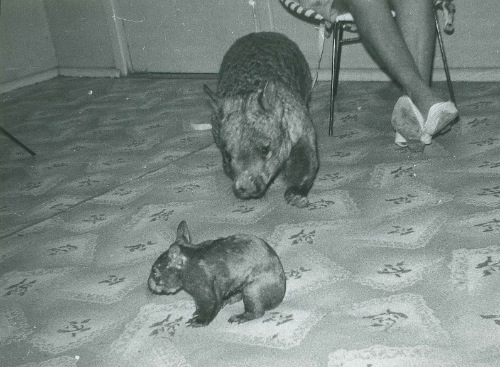
Female wombat and young bred by Brian Staker, Barmera.
George Woolmer has photographs of this wonderful phenomenon for our records. Some most interesting facts and photographs should emerge. Brian has notified the Fisheries and Fauna Dept. which is a condition of having a permit to keep the wombats from that department.
Brian and Richard are to be congratulated on this double success. It may not be the first time they have been bred but it is probably the 3rd and 4th time but it could be they will raise the young where others have failed. It is indeed a triumph for these two devoted naturalists to have succeeded. From this we can now gauge the turn of events and the stage at which young should appear on our reserve. It takes the guessing out of knowing when the births take place.
Further details will be published as they become available and continue to make history.
APRIL 1972 “NATURAL HISTORY”
WOMBAT NEWS
Brian Staker who caught a wombat in the 1967-8 drought was rewarded with the emergence of a baby wombat some months later. Now this wombat, raised in captivity to save it from starvation, has become a mother to the new baby we announced last month. We are pleased to correct the omission to this double success which has made Society history.
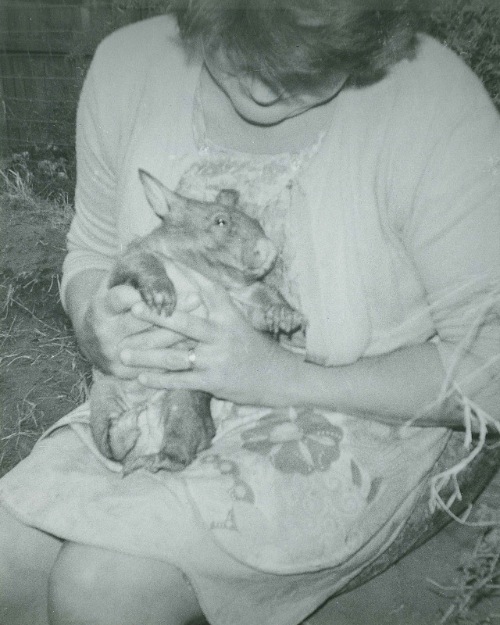
Second generation baby wombat born in captivity with Mrs Staker.
AUGUST 1972 “NATURAL HISTORY”
THE STORY OF ELVIS, MINI & MAXI
This is the story of HAIRY NOSED WOMBATS that were saved from almost certain death at Portee Station near Blanchetown, S.A.
The story starts in October 1967 when George Woolmer asked if I would like to attend a meeting of the Natural History Society of S.A. to be held at Portee to observe the plight of the wombats because of the severe drought then being experienced.
I had no idea of the habits of wombats but suggested that perhaps we could save a few by keeping them in back yards until the drought was over. While others agreed with this it was not as simple as it appeared. There was no problem with permits as the Department of Fisheries and Fauna Conservation had promised to help as much as possible because of the danger of this species becoming extinct.
We built yards to specifications supplied by the Department. These were later altered to suit local conditions. This meant under-laying the whole yard with cyclone wire to prevent the wombats digging out.
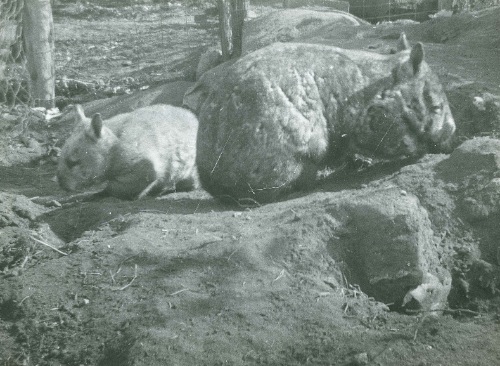
Mother wombat and offspring in yard at Brian Straker’s property, Barmera.
We received our first permit and arranged to go to Portee on Saturday, Dec. 8th.
When we arrived there the Conquests had already been at work and had caught one wombat; this animal was in poor condition, his coat was the colour and texture of old hessian and, although a big animal, weighed only 36lbs.
Jack thought this animal was a female so we set out to catch a male. After several hours’ work we succeeded and set off home with our pair of wombats. The animals were named Elsie and Ernie but when we got home we discovered that Elsie was a male and changed his name to Elvis.
The wombats were brought inside and spoon fed 3 times a day on a mixture of baby cereal, bran, pollard and powdered milk. This mixture later on had Webb’s kangaroo pellets added, and later still, chopped lucerne.
Ernie was ill the first week and was treated for pneumonia by our local doctor as there was not a veterinary doctor closer than 100 miles. He recovered O.K. and was given to my brother who also had a permit to keep a pair of wombats.
On the 6th Jan. 1968 we again went to Portee and caught one female which was in the last stages of starvation; although she was a full grown animal she weighed only 34½lbs. This animal was carefully nursed but she died two days later.
We caught two more females on the 14th Jan. 1968. George Woolmer kept one and I the other, which was in good condition and weighed 68lbs. On Jan. 29th the female became hard to feed and as time passed she refused to eat at all and died on Feb. 16th. A post-mortem was performed in Adelaide and it was discovered that she had died from peritonitis caused by a twisted bowel.
A new female was caught on April 1st 968. This animal, although given all of the recommended treatment, which included vitamin injection and Bi-cillin died on April 23rd.
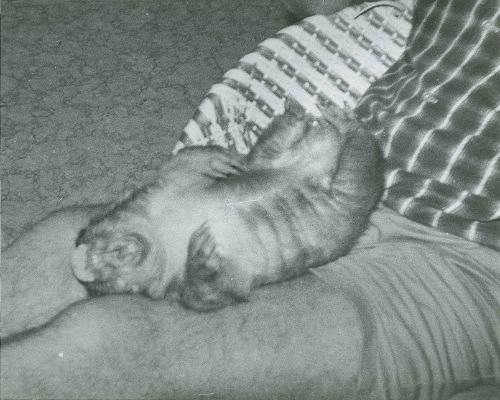
Baby wombat having a quiet snooze in Brian’s lap.
It must be understood that all of these animals were starved when we caught them and would probably have died anyway. Also there was very little known about the Hairy-nosed Wombat by anyone; in fact, Mrs. Christian, an Adelaide vet., was the only person who could help at all and she admitted that she was only applying knowledge of other animals and hoping it would work with wombats.
It was not until March 1969 that we were granted another permit to take a female wombat from Portee and because the drought had broken and the wombats were no longer starving, this permit stated that the animal had to be obtained within half a mile of the main road. This way an animal that might be killed by traffic would be saved.
We went to Portee on April 4th 1969 and camped over night; on the 5th we detected wombats in a burrow and started digging. The first hole we dug was 4ft. 6ins. deep. We knew the wombats were just in front of us, but it took three more holes 6ft. deep before we could catch one. Luck was with us and the animal was a female with a young one in her pouch. She was a large animal weighing 70lbs.
This animal was treated the same as previous ones and spoon fed on the cereal mixture, she progressed reasonably well except for having swollen toes on one foot. Mrs. Christian said this was probably “Lumpy Jaw” and she advised treatment with Bi-cillin. The animal was later taken to Adelaide and the diagnosis was confirmed and the treatment cured the disease eventually.
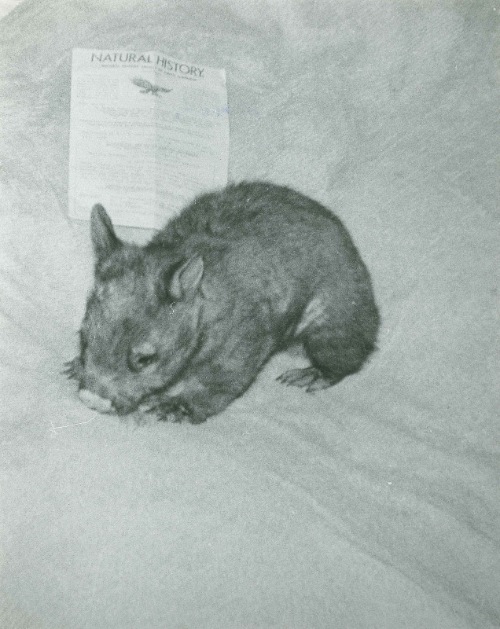
Baby wombat bred in captivity, Barmera.
That was the last trouble we had with the young one as far as health at least although we had plenty of excitement in other ways as it grew up.
The young one was a female and we called her Mini, she weighed only 4lbs. when she came out of the pouch but thrived on the mixture she was fed. Mini lived in the house with us, in a big box, which was lined with old coats and I installed a covered globe inside to provide heat.
BRIAN STAKER
To be continued next month.
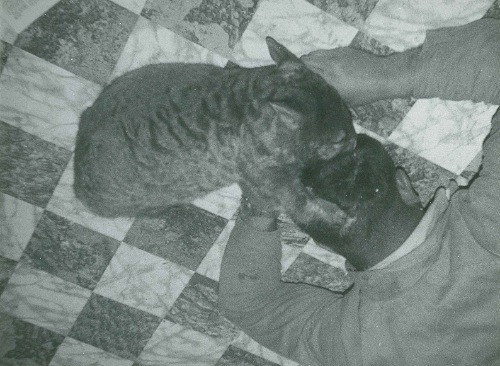
Baby wombat playing with Brian.
SEPTEMBER 1972 “NATURAL HISTORY”
THE STORY OF ELVIS, MINI & MAXI
continued.
Mini was a real pet and spent almost as much time being cuddled by one or other member of the family as she spent in her box. She would follow us all over the house and quite often had to be taken out of our beds. As she grew she used to chew and scratch her box until some one would take her out, this could be at any hour day or night, so when she was big enough she was banished to the wombat yard during the night.
Mini’s mother died in August. The cause was probably an infection in the intestines.
When we first got our wombats we were told that it was very rare for these animals to breed in captivity and in fact had only bred three times that were recorded and one of these was in West Germany.
By January 1971 Mini was fully grown and we had hopes that our wombats would mate when the time was right. About mid-August Mini appeared off colour and we feared that she was ill.
On Nov. 30th 1971, we discovered that Mini had a young in her pouch and we assume that it was born in mid-August when Mini was “off colour”.
We had achieved what was considered almost impossible, thanks to Mrs. Christian, the Natural History Society and the people who helped us catch the original animals.
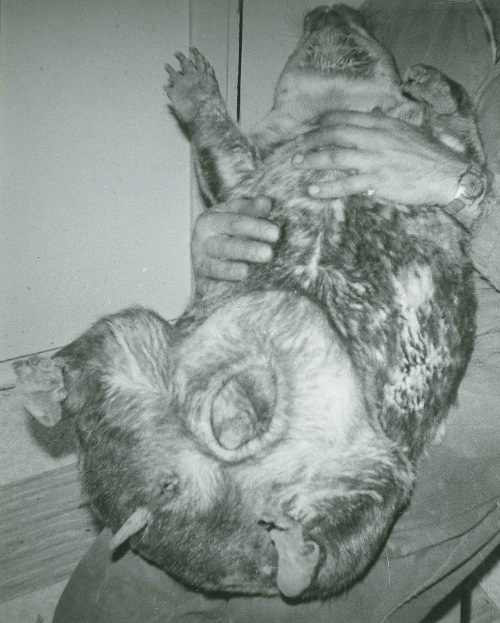
Female wombat showing young in backward facing marsupial pouch.
The new wombat first came out of the pouch on March 28th 1972 but soon went back in, again coming out on the 31st; this time we caught it and found that we had another male.
His vital statistics were:-
- Weight. 4lbs 9ozs.
- Length, Head and Body. 12 inches.
- Hind Foot. 2½ inches.
- Ear. 2 inches.
- Tail. 1? inches.
- Hind Leg., 2 inches.
- Width of Head. 2 inches.
- Length of Head. 3 inches.
The young was named Maxi because his mother was Mini but the name Ikey-mo is used just as often.
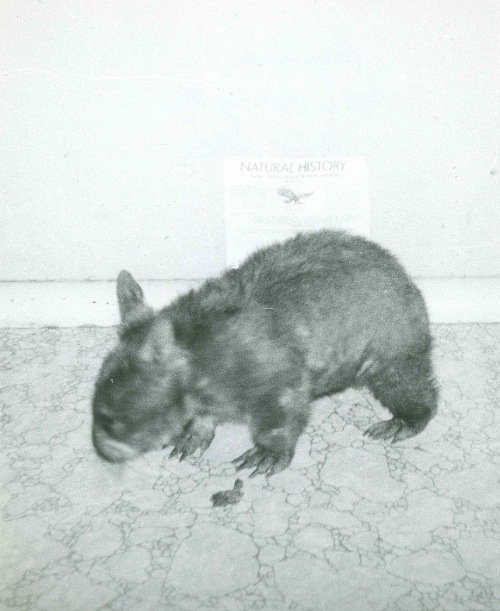
Baby wombat bred by Cath & Brian Staker, Barmera.
While Mini is still as tame as ever and will climb into our laps for a cuddle, Maxi is quite wild and will avoid us if possible. Maxi is still feeding from his mother, and in his method of feeding he is quite different from kangaroos; he suckles by pulling the teat outside of the pouch, and he is assisted in this by the teat being rigid and poking from the bottom of the pouch to just poke out of the mouth of the pouch. This makes it possible for Maxi to get the teal without even putting his nose in the pouch.
Maxi is a healthy young hairy-nosed wombat, unique as the rest of his species and rare in two ways, the species is listed as rare and he was bred in captivity, only the fourth to be recorded.
To finish this story, Maxi is the “spitting image” of his father Elvis, with identical markings but a lighter coloured coat at this stage.
We members of the Natural History Society have proved that the impossible can be done. All it takes is time and perseverance in the face of adversity and opposition.
The Society has done now the almost impossible twice; first Moorunde itself and now the breeding of the wombats in captivity.
BRIAN STAKER
